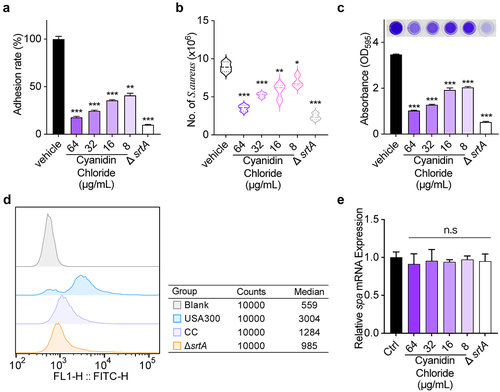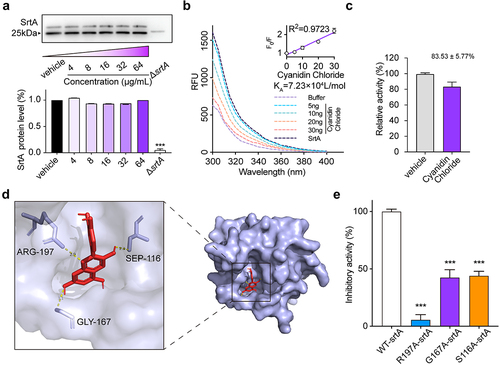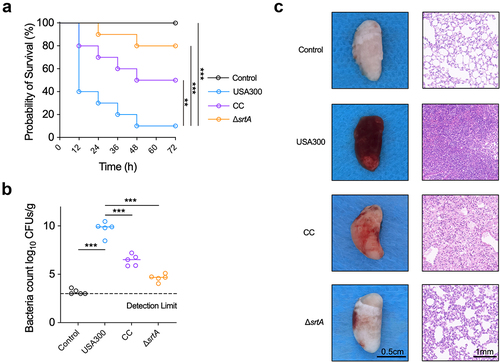Figures & data
Figure 1. Cyanidin chloride reversibly inhibited S. aureus SrtA activity. (a) SrtA inhibitors were screened from natural compounds based on FRET upon substrate cleavage, and cyanidin chloride was identified as an SrtA inhibitor. (b) Inhibitory effects of cyanidin chloride on the activity of S. aureus USA300 SrtA in vitro. (c) Cyanidin chloride could reversibly inhibit SrtA activity. (d) S. aureus USA300 growth curve with or without cyanidin chloride (64 μg/mL) and ΔsrtA group. (e) the percent cell viability of HepG2 cells measured by CCK8 assay after 24 h incubating with various concentrations of cyanidin chloride. (f) the LDH released from HepG2 cells treated with or without cyanidin chloride. * indicates P < 0.05, **indicates P < 0.01, and *** indicates P < 0.001 compared to the control group.

Figure 2. The influence of cyanidin chloride on SrtA-related phenotypes of S. aureus. (a) Effect of cyanidin chloride on the adhesion of S. aureus USA300 to fibrinogen. (b) the effect of cyanidin chloride on internalization of S. aureus into A549 cells. (c) Antagonistic effects of cyanidin chloride on S. aureus USA300 biofilm formation. (d) Flow cytometry analysis of S. aureus surface protein (SpA) stained with FITC-labeled rabbit IgG. (e) the transcript levels of spa in the presence of various concentrations of cyanidin chloride were determined by RT-qPCR. * indicates P < 0.05, **indicates P < 0.01, and *** indicates P < 0.001 compared to the untreated group.

Figure 3. The expression of SrtA in the presence of cyanidin chloride and between cyanidin chloride and StrA by fluorescence quenching assay. (a) Expression of SrtA in the S. aureus USA300 with different concentrations of cyanidin chloride by western blotting. (b) Binding affinity between cyanidin chloride and SrtA. The KA of cyanidin chloride and SrtA was calculated by plotting the Stern-Volmer SrtA quenching. (c) Molecular docking illustrated that the binding mode of cyanidin chloride in SrtA binding pocket. (d). WT-SrtA and SrtA mutants (S116A-SrtA, G167A-SrtA, R197A-SrtA) were incubated with 64 μg/mL cyanidin chloride, and the transepiptase activity of the recombinant SrtA was determined by FRET. *** P < 0.001 were calculated using one-way ANOVA.

Figure 4. Cyanidin chloride alleviated the infection of the S. aureus-induced pneumonia in mice. (a) Effect of cyanidin chloride on survival of mice (n=10) with S. aureus USA300 pneumonia was recorded in 12 h intervals for 4 days. The statistical significance was determined with the log-rank test (*** P < 0.001). (b) the bacterial load of the S. aureus USA300 in the mice lung treated with or without cyanidin chloride. The limit of lung bacterial load detection was 1×103. the statistical significance was determined with the Mann–Whitney test (***P < 0.001). (c) H&E staining and histopathology analysis of the mice lung tissues with or without treatment of cyanidin chloride (80 mg/kg).

